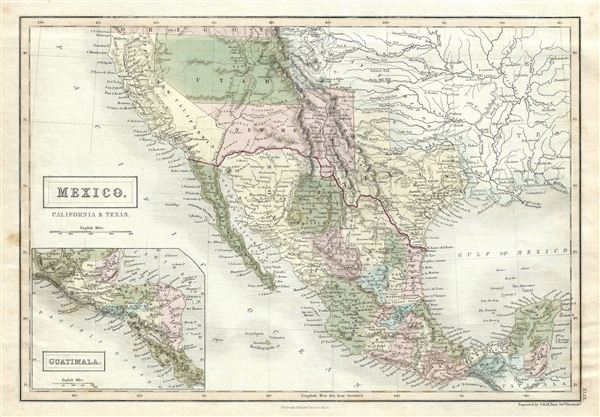This is a fine example of the 1851 Black Map of Mexico, California and Texas. It covers from the southern border of Oregon as far south as Guatemala including New Mexico (with modern day Arizona), Utah (with modern day Nevada), and California. An inset map on the lower left corner details Guatemala and Belize. The form of this map is odd, as in addition to Mexico, it includes the former Mexican territory of Upper California (including Utah and New Mexico Territories) which was ceded from Mexico at the end the Mexican American war in the 1848 Treaty of Guadeloupe Hidalgo. This suggests that the Blacks found it easier to update an earlier map to reflect these political changes rather than to issue a completely new Mexico map - even though several years had passed since the Treaty. Texas, in 1845, following nearly a decade of semi-independence, joined the United States, becoming its 28th state and is here shown as part of the United States. The map erroneously combines Great Salt Lake and Utah Lake - a curious and uncommon mistake that is most likely merely an engravers blunder. The interiors of the western United States remain relatively unmapped though coastlines are accurately rendered. Various cities, towns, rivers, mountains and other topographical details are noted with relief shown by hachures. This map was engraved by Sidney Hall and issued as plate no. LVIX in the 1851 edition of Black's General Atlas of the World.
CartographerS
Charles and Adam Black (fl. 1807 - present) were map and book publishers based in Edinburgh. Charles and his uncle, Adam, both of Edinburgh, Scotland, founded their publishing firm in 1807. They published a series of maps and atlases throughout the 19th century. In addition to an array of atlases, the Black firm is known for their editions of the Encyclopedia Britannica (1817 - 1826) and the first publishing of Sir Walter Scott's novels in 1854. In 1889 the A. & C. Black publishing house moved to London where it remains in operation to this day. More by this mapmaker...
Sidney Hall (1788 - 1831) was an English engraver and map publisher active in London during the late 18th and early 19th centuries. His earliest imprints, dating to about 1814, suggest a partnership with Michael Thomson, another prominent English map engraver. Hall engraved for most of the prominent London map publishers of his day, including Aaron Arrowsmith, William Faden, William Harwood, and John Thomson, among others. Hall is credited as being one of the earliest adopters of steel plate engraving, a technique that allowed for finer detail and larger print runs due to the exceptional hardness of the medium. Upon his early death - he was only in his 40s - Hall's business was inherited by his wife, Selina Hall, who continued to publish under the imprint, "S. Hall", presumably for continuity. The business eventually passed to Sidney and Selina's nephew Edward Weller, who became extremely prominent in his own right. Learn More...
Source
Black, A. and C., General Atlas Of The World, (Edinburgh) 1851.
Black's General Atlas was a popular Scottish atlas of the world issued by the Edinburgh firm of Adam and Charles Black. This atlas was first issued in 1840 with subsequent editions being printed well into the 1890s. While most editions were printed in Edinburgh, an American edition was issued in 1857. Most early editions of his atlas were engraved by S. Hall. Typically this refers to Sidney Hall, who died in 1831, but in this case, since the engraving was initiated well after his death, it was most likely his widow, Selina Hall, who did the engraving. Later editions feature additional maps updated and engraved by William Hughes. Early editions featured outline color only, but later editions embraced a full color approach with pale green, yellow, and blue pastels. All editions are known for their meticulous presentation of the most up-to-date cartographic information. Moreover, this exceptionally long publication run provides a fine cartographic record of the middle to late 19th century - particularly as regards the complex cartographic evolution of the Americas through this period.
Very good. Minor overall toning. Blank on verso. Minor foxing.
Rumsey 2305.059 (1854 edition). Philips (atlases) 4334.


